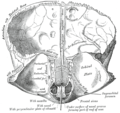Falx cerebri
Falx Cerebri
The falx cerebri is a dural fold that extends into the longitudinal fissure between the two cerebral hemispheres of the human brain. It is one of the dural septa, partitions of the dura mater, which is the outermost of the three layers of the meninges that surround the brain and spinal cord. The primary role of the falx cerebri is to help support and protect the brain by limiting its movement within the skull.
Structure[edit]
The falx cerebri is anchored anteriorly to the crista galli of the ethmoid bone and posteriorly to the internal occipital protuberance. It is narrow in front, where it is attached to the crista galli, and becomes wider as it progresses posteriorly. The inferior edge of the falx cerebri contains the superior sagittal sinus and the inferior sagittal sinus, which are important venous channels that drain blood from the brain back to the heart.
Function[edit]
The main function of the falx cerebri is to separate the two cerebral hemispheres and provide a supportive structure for the brain. By doing so, it plays a crucial role in protecting the brain from jarring movements that could cause injury. Additionally, the sinuses contained within the falx cerebri are essential for venous blood drainage from the brain.
Clinical Significance[edit]
- Intracranial Hemorrhage
The falx cerebri can be involved in certain types of intracranial hemorrhage, such as subdural hematoma, which occurs beneath the dura mater. Trauma to the head can lead to tearing of the veins that bridge the cerebral cortex and the dural sinuses, potentially causing blood to accumulate in this area.
- Falx Cerebri Tumors
Although rare, tumors can develop in the falx cerebri. These are usually meningiomas, which are typically benign tumors that arise from the meninges. Symptoms of a falx cerebri tumor can include headaches, seizures, and other neurological deficits, depending on the size and location of the tumor.
Diagnosis[edit]
Imaging techniques such as magnetic resonance imaging (MRI) and computed tomography (CT) scans are crucial for diagnosing conditions related to the falx cerebri. These imaging modalities can provide detailed images of the falx cerebri, helping to identify abnormalities such as tumors or signs of hemorrhage.
Treatment[edit]
Treatment for conditions affecting the falx cerebri depends on the underlying cause. For tumors, surgical removal is often necessary, especially if the tumor is causing symptoms. In the case of intracranial hemorrhage, treatment may involve managing the symptoms, monitoring the patient, and in some cases, surgical intervention to relieve pressure on the brain.
-
Falx cerebri
-
Falx cerebri
-
Falx cerebri
-
Falx cerebri
-
Falx cerebri
Ad. Transform your life with W8MD's Budget GLP-1 injections from $75


W8MD offers a medical weight loss program to lose weight in Philadelphia. Our physician-supervised medical weight loss provides:
- Weight loss injections in NYC (generic and brand names):
- Zepbound / Mounjaro, Wegovy / Ozempic, Saxenda
- Most insurances accepted or discounted self-pay rates. We will obtain insurance prior authorizations if needed.
- Generic GLP1 weight loss injections from $75 for the starting dose.
- Also offer prescription weight loss medications including Phentermine, Qsymia, Diethylpropion, Contrave etc.
NYC weight loss doctor appointmentsNYC weight loss doctor appointments
Start your NYC weight loss journey today at our NYC medical weight loss and Philadelphia medical weight loss clinics.
- Call 718-946-5500 to lose weight in NYC or for medical weight loss in Philadelphia 215-676-2334.
- Tags:NYC medical weight loss, Philadelphia lose weight Zepbound NYC, Budget GLP1 weight loss injections, Wegovy Philadelphia, Wegovy NYC, Philadelphia medical weight loss, Brookly weight loss and Wegovy NYC
|
WikiMD's Wellness Encyclopedia |
| Let Food Be Thy Medicine Medicine Thy Food - Hippocrates |
Medical Disclaimer: WikiMD is not a substitute for professional medical advice. The information on WikiMD is provided as an information resource only, may be incorrect, outdated or misleading, and is not to be used or relied on for any diagnostic or treatment purposes. Please consult your health care provider before making any healthcare decisions or for guidance about a specific medical condition. WikiMD expressly disclaims responsibility, and shall have no liability, for any damages, loss, injury, or liability whatsoever suffered as a result of your reliance on the information contained in this site. By visiting this site you agree to the foregoing terms and conditions, which may from time to time be changed or supplemented by WikiMD. If you do not agree to the foregoing terms and conditions, you should not enter or use this site. See full disclaimer.
Credits:Most images are courtesy of Wikimedia commons, and templates, categories Wikipedia, licensed under CC BY SA or similar.
Translate this page: - East Asian
中文,
日本,
한국어,
South Asian
हिन्दी,
தமிழ்,
తెలుగు,
Urdu,
ಕನ್ನಡ,
Southeast Asian
Indonesian,
Vietnamese,
Thai,
မြန်မာဘာသာ,
বাংলা
European
español,
Deutsch,
français,
Greek,
português do Brasil,
polski,
română,
русский,
Nederlands,
norsk,
svenska,
suomi,
Italian
Middle Eastern & African
عربى,
Turkish,
Persian,
Hebrew,
Afrikaans,
isiZulu,
Kiswahili,
Other
Bulgarian,
Hungarian,
Czech,
Swedish,
മലയാളം,
मराठी,
ਪੰਜਾਬੀ,
ગુજરાતી,
Portuguese,
Ukrainian





